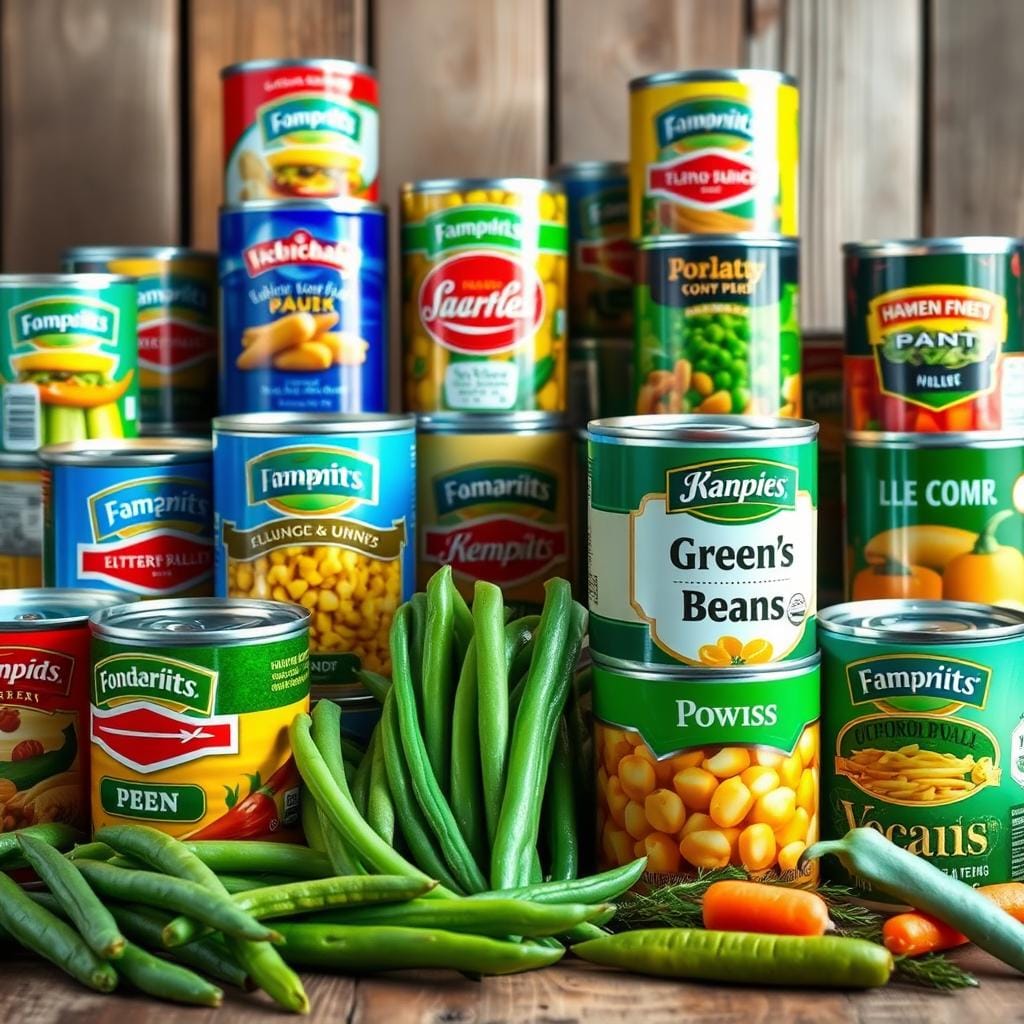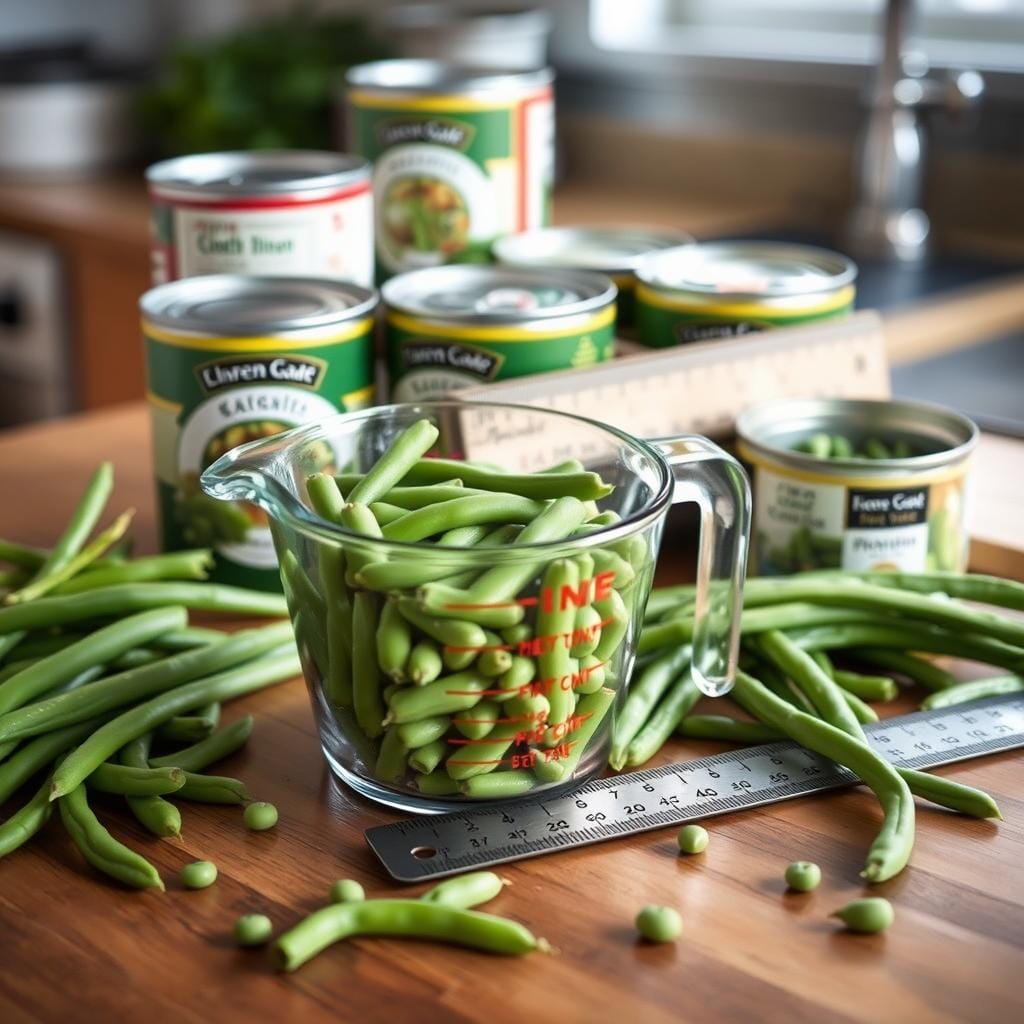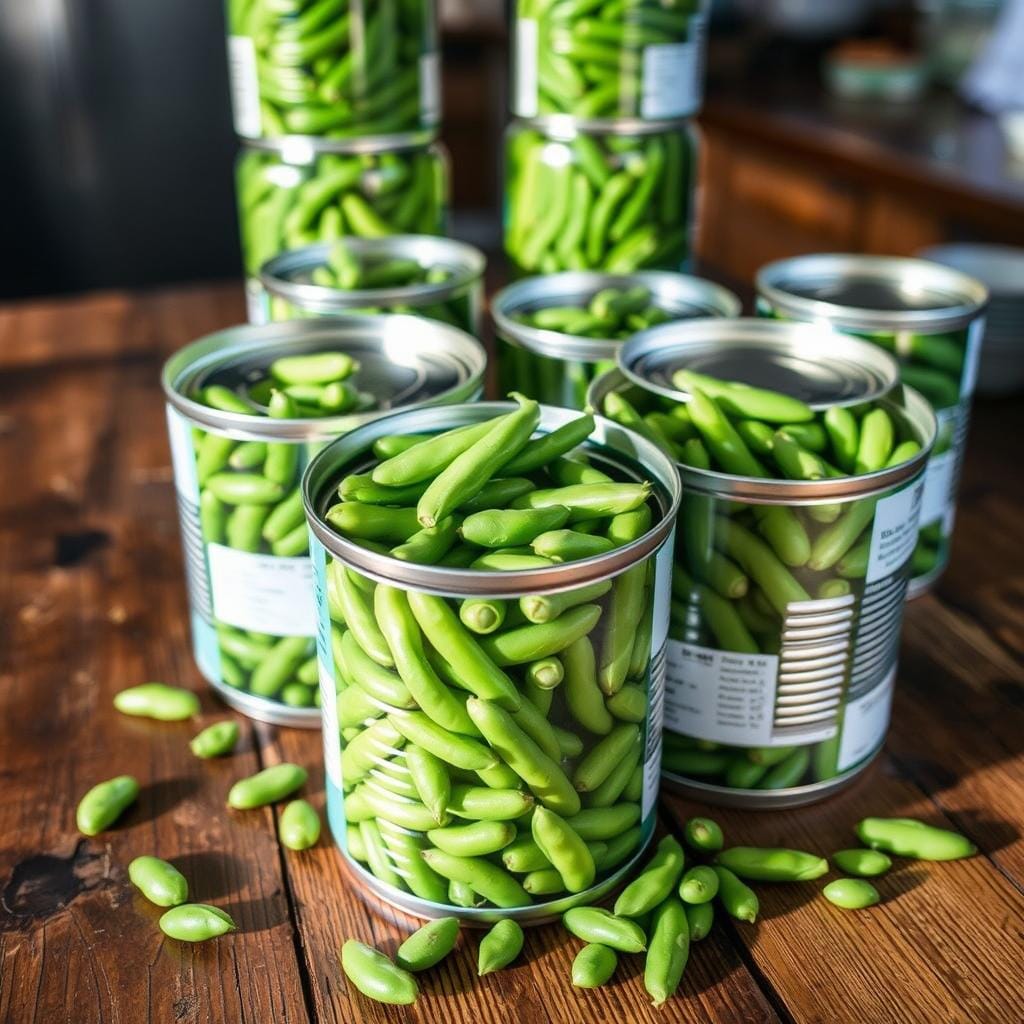As a passionate home cook, I’ve often found myself wondering: how many cans of green beans make 4 cups? The humble green bean, a staple in many households, can be tricky to portion when converting canned measurements for recipes. If you’ve ever stared at a can and questioned how much it will yield, you’re not alone! Let’s break it down and simplify the process.
But today, we’re going to unravel the mystery. We’ll give you a quick, easy-to-follow guide on how to measure canned green beans. You’ll learn how to achieve the perfect 4-cup serving.
Key Takeaways
- Learn the standard can sizes for canned green beans and how to determine the net weight vs. drained weight.
- Discover the industry standards for canning green beans to ensure accurate measurements.
- Explore the different techniques for converting canned green beans to cup measurements, considering both drained and undrained options.
- Gain tips on how to measure canned green beans accurately, including proper draining and rinsing methods.
- Understand the nutritional differences between canned and fresh green beans to make informed choices.
Understanding Standard Can Sizes for Green Beans
Knowing the standard can sizes for green beans is key for cooking. The can size affects how much green beans you need for your dishes.
Common Commercial Can Sizes
In the United States, the common can sizes for green beans are:
- 8 oz. (small or “petite” can)
- 14.5 oz. (standard can)
- 28 oz. (large can)
Net Weight vs. Drained Weight
It’s important to know the difference between net weight and drained weight. Net weight includes the liquid, while drained weight is just the green beans.
Industry Standards for Canning
The canning industry has set standards for quality and consistency. These standards cover minimum drained weight, liquid amount, and can fill. Following these standards ensures a consistent product for consumers.

Understanding can sizes and industry standards helps in planning recipes. It ensures accurate measurements and consistent results in cooking.
How Many Cans of Green Beans Make 4 Cups?
Finding out how many cans of green beans make 4 cups can be tricky. It depends on the can size and whether you drain the beans or not.
One standard 15-ounce can of green beans usually gives you 1 1/2 to 2 cups of drained, cooked beans. So, to get 4 cups, you’ll need to open two to three cans.
| Can Size | Drained Green Beans (Cups) | Cans Needed for 4 Cups |
|---|---|---|
| 14.5 oz | 1.5-2 cups | 2-3 cans |
| 15 oz | 1.5-2 cups | 2-3 cans |
| 16 oz | 2-2.5 cups | 2 cans |
The exact amount can vary. This is due to factors like the brand, the green bean cut, and how packed they are. For the most accurate measurement, check the nutrition label on the can.
“The number of cans needed to make 4 cups of green beans can range from 2 to 3, depending on the can size.”
Knowing how many cans you need helps when a recipe asks for a specific amount. This way, you can plan your green bean measurements better.

Converting Canned Green Beans to Cup Measurements
Converting canned green beans to cups is key for great recipes. You need to think about the liquid and if the beans are drained or not.
Liquid Content Considerations
The liquid in canned green beans changes the volume a lot. They often have water, vegetable broth, or other liquids to preserve them. When you measure, remember this liquid and adjust your cups.
Drained vs. Undrained Conversions
There are two ways to measure canned green beans: drained or undrained. Drained beans give a precise measurement since the liquid is gone. Undrained beans include the liquid and might make your cups higher.
- Drained green beans: 1 (15 oz) can ≈ 1 1/2 cups
- Undrained green beans: 1 (15 oz) can ≈ 2 cups
Keep in mind, these are just estimates. The exact amount can vary by brand and can size. Always check the can’s label for the best info.
Knowing about the liquid and drained vs. undrained beans helps make your recipes better. This leads to tasty and fulfilling dishes every time.
Tips for Measuring Canned Green Beans Accurately
Measuring canned green beans accurately is key in cooking. It makes a big difference in your dishes. Whether it’s a classic casserole or a new recipe, getting the measurements right is crucial. Here are some tips to help you measure canned green beans like a pro.
Utilize Appropriate Measuring Tools
Get a good set of measuring cups and spoons for cooking. These tools help you measure canned green beans accurately. You can use cups, ounces, or grams. Don’t guess the amount, as it can mess up your dish.
Drain and Measure Separately
Drain the green beans before measuring. The liquid in the can can throw off your measurements. After draining, measure the solid green beans as your recipe says.
Consider Water Displacement
If you don’t have measuring cups, use water displacement. Put the drained beans in a liquid measuring cup and add water. The water level will show you how many cups of green beans you have.
Weigh for Precision
For the most precise measurements, use a digital kitchen scale. This is great when a recipe asks for a specific weight. Weighing the beans ensures you get the exact amount needed.
By using these tips, you’ll get better at measuring canned green beans. This will improve your cooking skills and make your recipes perfect every time.
Storage and Shelf Life of Canned Green Beans
Keeping canned green beans fresh is crucial. By following a few simple steps, you can keep them tasty for longer. These canned vegetables are great for many meals.
Proper Storage Conditions
Store canned green beans in a cool, dark spot. The best temperature is between 50°F and 70°F. Don’t keep them near sunlight or heat, as this can cause them to spoil faster.
After opening, move the beans to an airtight container. Then, refrigerate them. This stops air and bacteria from getting in, helping your kitchen hacks and meal planning stay on track.
Signs of Spoilage
Watch for signs of spoilage in canned green beans. Look for bulging, leaking, or dented cans. If the smell is off or the beans look different, throw them away. This prevents food poisoning.
| Proper Storage Conditions | Signs of Spoilage |
|---|---|
|
|
By storing them right and watching for spoilage, you can enjoy canned green beans for months. They’re a great addition to your meal planning and kitchen hacks.
Nutritional Value of Canned vs. Fresh Green Beans
The debate between canned and fresh green beans often focuses on their nutritional value. Both options have essential vitamins and minerals. However, there are key differences to consider when choosing.
Fresh green beans have more vitamins like vitamin C and vitamin K. These nutrients can decrease during canning. But, canned green beans have more vitamin A, making them good for portion control and meal planning.
Canned green beans are convenient because they’re pre-portioned and ready to use. This is great for those who focus on portion control or meal planning. Fresh green beans need more prep and can be harder to portion accurately.
“Canned green beans can be a good choice when you want the convenience of a pre-portioned vegetable, but fresh green beans are the healthier option if you have the time to prepare them.”
The choice between canned and fresh green beans depends on your preferences and needs. Knowing the nutritional differences helps you make a choice that suits your lifestyle and health goals.
Best Practices for Draining and Rinsing Green Beans
Learning how to drain and rinse canned green beans is key to better cooking. It can make your dishes taste and feel better. Whether you’re a pro in the kitchen or new to cooking, knowing these tips can improve your meals a lot.
Proper Draining Techniques
To get your canned green beans ready for cooking, follow these easy steps:
- Open the can and pour the beans into a colander or mesh strainer over the sink.
- Shake or stir the beans gently to let the extra liquid drain. Don’t press or squeeze them to avoid mushiness.
- If your recipe needs drained beans, you’re good to go. If it requires rinsed beans, move on to the next step.
When to Rinse Your Green Beans
Rinsing canned green beans isn’t always needed, but it’s good in some cases. Rinse them when:
- Reducing sodium content: Rinsing can help lower sodium levels if you’re watching your salt intake.
- Improving flavor: It can also remove tinny or metallic tastes, making the beans taste fresher.
- Preparing for specific recipes: Some dishes, like green bean casserole or sautéed green beans, need rinsed beans to avoid being too salty or watery.
By using these tips for draining and rinsing canned green beans, you can boost your cooking skills. You’ll make your recipes better and enjoy tasty green bean dishes every time.
Recipe Adjustments When Using Canned Green Beans
When you swap canned green beans for fresh, a few tweaks are needed. These changes ensure your dish tastes great and feels right. It’s all about mastering the art of cooking with canned goods.
One key thing is the cooking time. Canned beans are already cooked, so they cook faster. Cut the cooking time in half to avoid mushiness.
Seasoning is another area to focus on. Canned beans might taste stronger than fresh ones. Start with less salt and spices, then add more if needed. This keeps your dish balanced.
Think about the liquid in canned beans too. You might need to use less broth or water. Find the right mix to keep your dish just right.
Using canned green beans well means being open to changes. With practice, you’ll make tasty meals that meet your cooking goals.
“Canned green beans can be a convenient and affordable alternative to fresh, but it’s important to understand how to properly incorporate them into your recipes.”
Money-Saving Tips for Buying Canned Green Beans
Canned green beans are great for saving money in your kitchen. They’re perfect for meal planning and controlling portions. Here are some money-saving tips for buying canned green beans.
- Embrace bulk buying: Buying canned green beans in bulk can save you a lot of money. Look for sales and discounts to make it even cheaper.
- Compare prices across stores: Check the prices of canned green beans at different places. You might find better deals at some stores or brands. This can help you save more money.
- Opt for store brands: Store-brand canned green beans are often just as good as name-brand ones but cheaper. Try these alternatives to find what you like best.
Using these kitchen hacks and meal planning tips can help you save money on canned green beans. They’re convenient and versatile. A little smart shopping can help you eat well and stay within your budget.
Conclusion
In this article, we’ve looked at how to measure canned green beans for a perfect 4-cup portion. We’ve covered everything from standard can sizes to converting measurements. Now, you have the skills to confidently use canned green beans in any recipe.
Whether you’re making a classic green bean casserole or trying something new, knowing the right amount of green beans is key. This knowledge helps you get consistent, tasty results. By understanding drained versus undrained measurements, you can make your dishes even better.
As you keep cooking, remember the main points from this guide. Always check industry standards, think about the liquid content, and measure carefully. With these tips, you’ll be able to use canned green beans in many recipes. You’ll show off your cooking skills in the kitchen.

